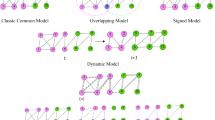Abstract
Nature-inspired optimization Algorithms (NIOAs) are nowadays a popular choice for community detection in social networks. Community detection problem in social network is treated as an optimization problem, where the objective is to either maximize the connection within the community or minimize connections between the communities. To apply NIOAs, either of the two, or both objectives are explored. Since NIOAs mostly exploit randomness in their strategies, it is necessary to analyze their performance for specific applications. In this paper, NIOAs are analyzed for the community detection problem. A direct comparison approach is followed to perform the pairwise comparison of NIOAs. The performance is measured in terms of five scores designed based on the prasatul matrix and also with average isolability. Three widely used real-world social networks and four NIOAs are considered for analyzing the quality of communities generated by NIOAs.
Access this chapter
Tax calculation will be finalised at checkout
Purchases are for personal use only
Similar content being viewed by others
References
Biswas A, Mishra KK, Tiwari S, Misra AK (2013) Physics-inspired optimization algorithms: a survey. J Optim (2013)
Talbi E (2009) Metaheuristics: from design to implementation. Wiley
Nadimi-Shahraki MH, Moeini E, Taghian S, Mirjalili S (2021) DMFO-CD: a discrete moth-flame optimization algorithm for community detection. Algorithms 14(11):314
Elbeltagi E, Hegazy T, Grierson D (2005) Comparison among five evolutionary-based optimization algorithms. Adv Eng Inform 19(1):43–53
Sarkar D, Biswas A (2022) Comparative performance analysis of recent evolutionary algorithms. Evolution in computational intelligence. Springer, pp 151–159
Sureja N (2012) New inspirations in nature: a survey. Int J Comput Appl Inf Technol 1(3):21–24
Taghian S, Nadimi-Shahraki MH, Zamani H (2018) Comparative analysis of transfer function-based binary metaheuristic algorithms for feature selection. In: 2018 international conference on artificial intelligence and data processing (IDAP). IEEE, pp 1–6
Biswas A, Biswas B (2017) Regression line shifting mechanism for analyzing evolutionary optimization algorithms. Soft Comput 21(21):6237–6252
Liu Q, Zhou B, Li S, Li A, Zou P, Jia Y (2016) Community detection utilizing a novel multi-swarm fruit fly optimization algorithm with hill-climbing strategy. Arab J Sci Eng 41(3):807–828
Biswas A, Gupta P, Modi M, Biswas B (2015) An empirical study of some particle swarm optimizer variants for community detection. Advances in intelligent informatics. Springer, pp 511–520
Biswas A, Biswas B (2017) Analyzing evolutionary optimization and community detection algorithms using regression line dominance. Inf Sci 396:185–201
Khan BS, Niazi MA (2017) Network community detection: a review and visual survey. arXiv preprint. arXiv:1708.00977
Glover F, Samorani M (2019) Intensification, diversification and learning in metaheuristic optimization. J Heuristics 25(4):517–520
Bara’a AA, Abbood AA, Hasan AA, Pizzuti C, Al-Ani M, Özdemir S, Al-Dabbagh RD (2021) A review of heuristics and metaheuristics for community detection in complex networks: current usage, emerging development and future directions. Swarm Evol Comput 63:100885
Osaba E, Del Ser J, Camacho D, Bilbao MN, Yang X-S (2020) Community detection in networks using bio-inspired optimization: latest developments, new results and perspectives with a selection of recent meta-heuristics. Appl Soft Comput 87:106010
Mirjalili S, Mohammad Mirjalili S, Lewis A (2014) Grey wolf optimizer. Adv Eng Softw 69:46–61
Mirjalili S (2016) SCA: a sine cosine algorithm for solving optimization problems. Knowl-Based Syst 96:120–133
Nadimi-Shahraki MH, Fatahi A, Zamani H, Mirjalili S, Abualigah L, Abd Elaziz M (2021) Migration-based moth-flame optimization algorithm. Processes 9(12):2276
Mirjalili S, Lewis A (2016) The whale optimization algorithm. Adv Eng Softw 95:51–67
Buluc A, Meyerhenke H, Safro I, Sanders P, Schulz C (2013) Recent advances in graph partitioning
Chakraborty T, Dalmia A, Mukherjee A, Ganguly N (2017) Metrics for community analysis: a survey. ACM Comput Surv (CSUR) 50(4):1–37
Das S, Biswas A (2021) Deployment of information diffusion for community detection in online social networks: a comprehensive review. IEEE Trans Comput Soc Syst 8(5):1083–1107
Ferligoj A, Batagelj V (1992) Direct multicriteria clustering algorithms. J Classification 9(1):43–61
Biswas A (2022) Prasatul matrix: a direct comparison approach for analyzing evolutionary optimization algorithms. arXiv preprint. arXiv:2212.00671
Zachary WW (1977) An information flow model for conflict and fission in small groups. J Anthropol Res 33(4):452–473
Lusseau D, Schneider K, Boisseau OJ, Haase P, Slooten E, Dawson SM (2003) The bottlenose dolphin community of doubtful sound features a large proportion of long-lasting associations. Behav Ecol Sociobiol 54(4):396–405
Girvan M, Newman MEJ (2002) Community structure in social and biological networks. Proc Natl Acad Sci 99(12):7821–7826
Biswas A, Biswas B (2017) Defining quality metrics for graph clustering evaluation. Expert Syst Appl 71:1–17
Acknowledgements
This research work is supported by the Science and Engineering Board (SERB), Department of Science and Technology (DST) of the Government of India under Grant No. EEQ/2019/000657.
Author information
Authors and Affiliations
Corresponding author
Editor information
Editors and Affiliations
Rights and permissions
Copyright information
© 2023 The Author(s), under exclusive license to Springer Nature Singapore Pte Ltd.
About this paper
Cite this paper
Das, S., Singha, B., Tonda, A., Biswas, A. (2023). Direct Comparative Analysis of Nature-Inspired Optimization Algorithms on Community Detection Problem in Social Networks. In: Shakya, S., Papakostas, G., Kamel, K.A. (eds) Mobile Computing and Sustainable Informatics. Lecture Notes on Data Engineering and Communications Technologies, vol 166. Springer, Singapore. https://doi.org/10.1007/978-981-99-0835-6_45
Download citation
DOI: https://doi.org/10.1007/978-981-99-0835-6_45
Published:
Publisher Name: Springer, Singapore
Print ISBN: 978-981-99-0834-9
Online ISBN: 978-981-99-0835-6
eBook Packages: Intelligent Technologies and RoboticsIntelligent Technologies and Robotics (R0)




